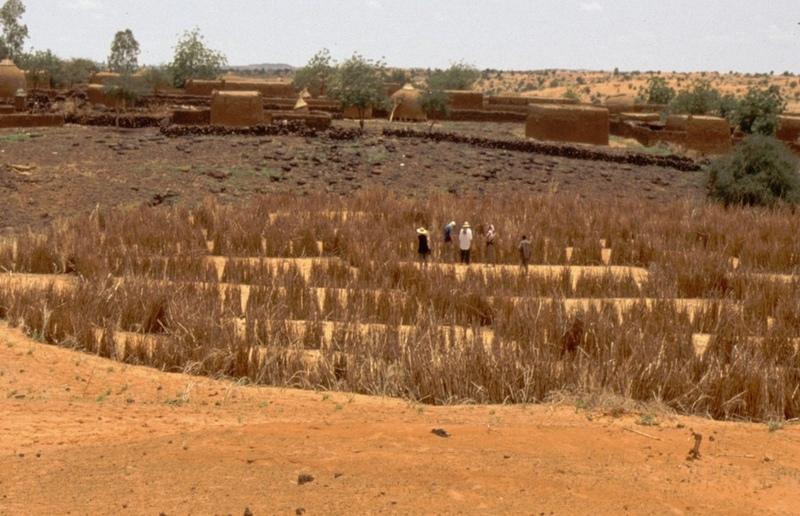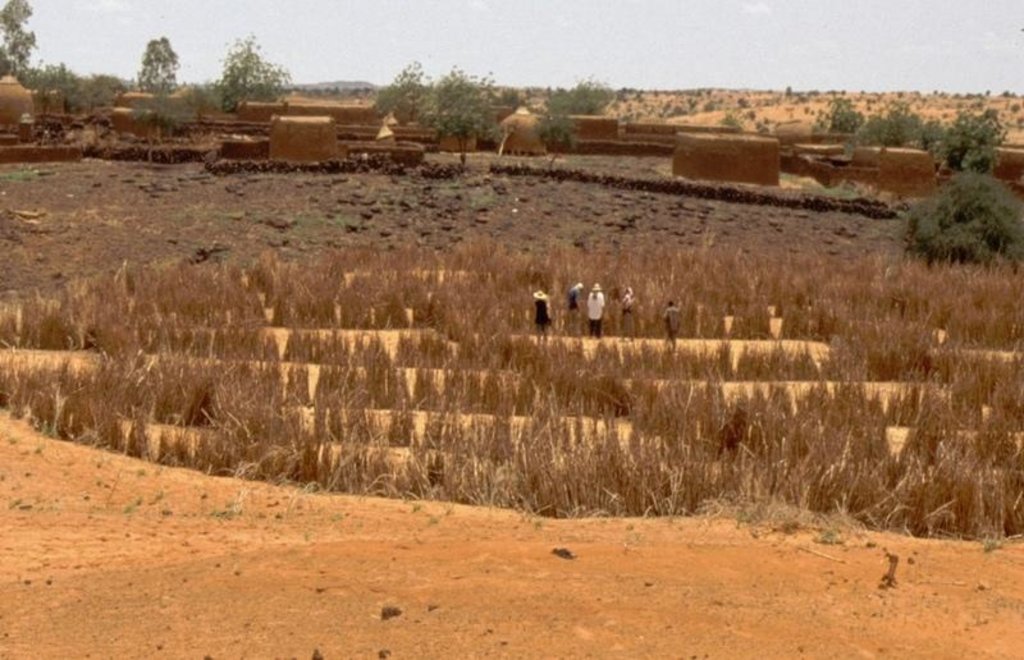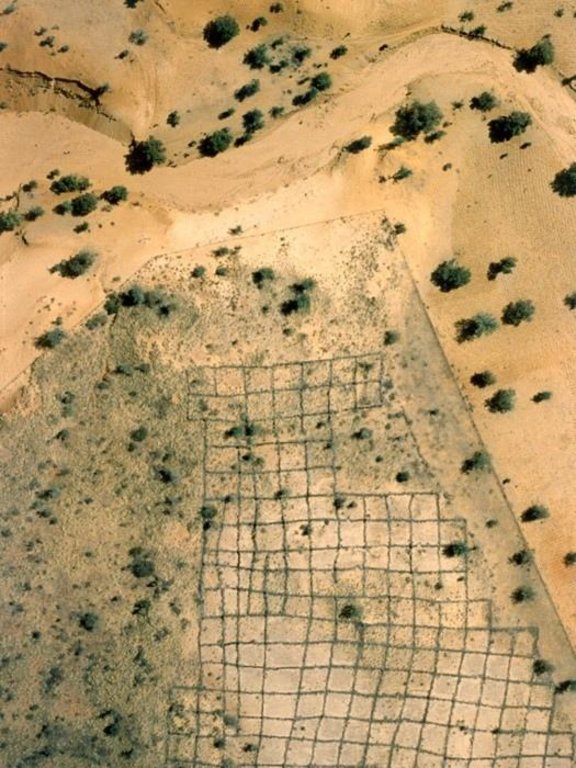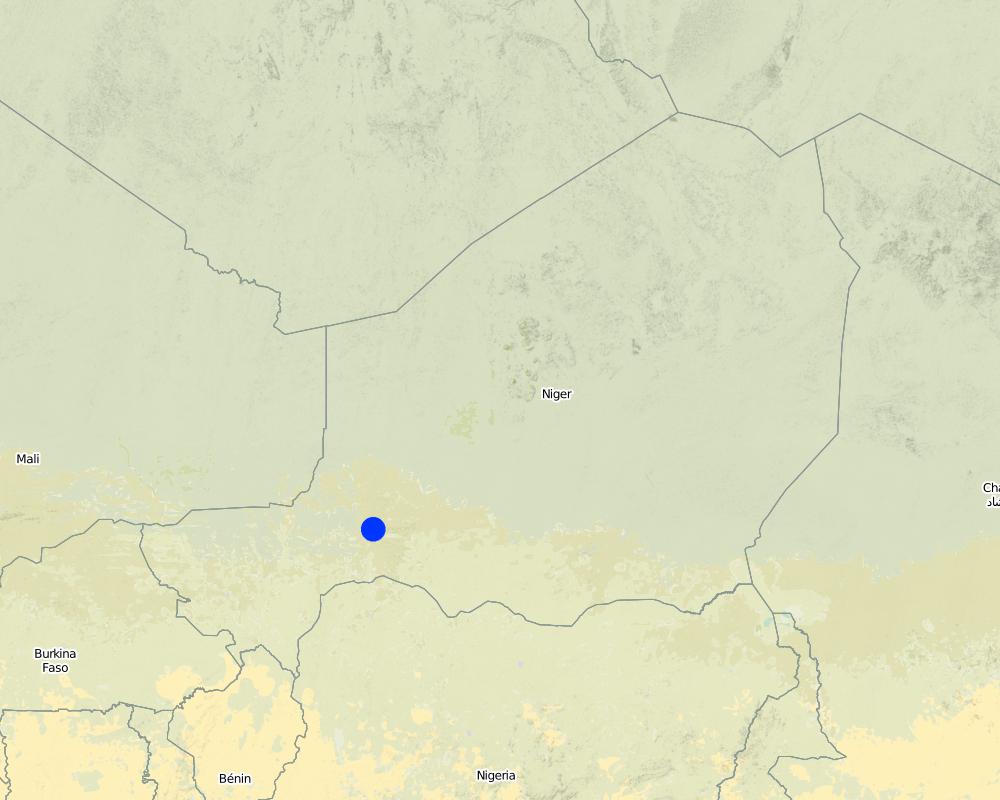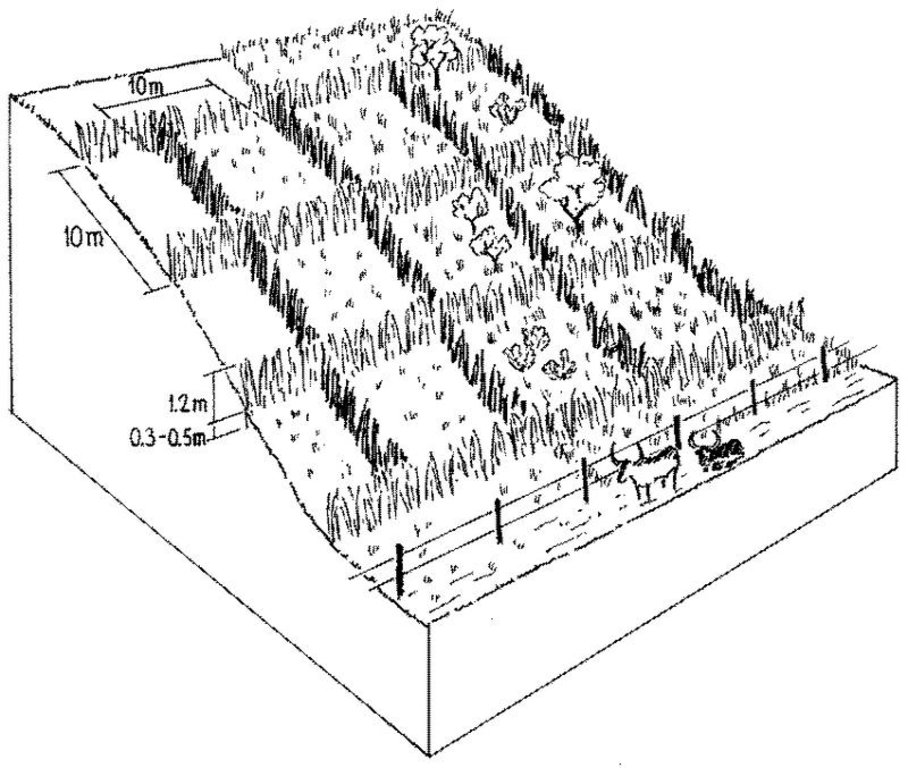Sand dune stabilisation [ប្រទេសនីហ្សេ]
- ការបង្កើត៖
- បច្ចុប្បន្នភាព
- អ្នកចងក្រង៖ Charles Bielders
- អ្នកកែសម្រួល៖ –
- អ្នកត្រួតពិនិត្យច្រើនទៀត៖ David Streiff, Deborah Niggli, Alexandra Gavilano
Fixation des dunes
technologies_1101 - ប្រទេសនីហ្សេ
ពិនិត្យមើលគ្រប់ផ្នែក
ពង្រីកមើលទាំងអស់ បង្រួមទាំងអស់1. ព័ត៌មានទូទៅ
1.2 ព័ត៌មានលម្អិតពីបុគ្គលសំខាន់ៗ និងស្ថាប័នដែលចូលរួមក្នុងការវាយតម្លៃ និងចងក្រងឯកសារនៃបច្ចេកទេស
អ្នកជំនាញឯកទេស SLM:
អ្នកជំនាញឯកទេស SLM:
អ្នកជំនាញឯកទេស SLM:
ឈ្មោះគម្រោងដែលបានចងក្រងឯកសារ/ វាយតម្លៃលើបច្ចេកទេស (បើទាក់ទង)
Projet de développement rural de Tahoua, Niger (PDRT)ឈ្មោះគម្រោងដែលបានចងក្រងឯកសារ/ វាយតម្លៃលើបច្ចេកទេស (បើទាក់ទង)
Book project: where the land is greener - Case Studies and Analysis of Soil and Water Conservation Initiatives Worldwide (where the land is greener)ឈ្មោះអង្គភាពមួយ (ច្រើន) ដែលបានចងក្រងឯកសារ/ វាយតម្លៃបច្ចេកទេស (បើទាក់ទង)
Université catholique de Louvain (Université catholique de Louvain) - ប្រទេសបែលហ្ស៊ិកឈ្មោះអង្គភាពមួយ (ច្រើន) ដែលបានចងក្រងឯកសារ/ វាយតម្លៃបច្ចេកទេស (បើទាក់ទង)
Centre for Agriculture in the Tropics and Subtropics (Centre for Agriculture in the Tropics and Subtropics) - ប្រទេសអាល្លឺម៉ង់ឈ្មោះអង្គភាពមួយ (ច្រើន) ដែលបានចងក្រងឯកសារ/ វាយតម្លៃបច្ចេកទេស (បើទាក់ទង)
ICRISAT (ICRISAT) - ប្រទេសនីហ្សេឈ្មោះអង្គភាពមួយ (ច្រើន) ដែលបានចងក្រងឯកសារ/ វាយតម្លៃបច្ចេកទេស (បើទាក់ទង)
CDE Centre for Development and Environment (CDE Centre for Development and Environment) - ប្រទេសស្វ៊ីសឈ្មោះអង្គភាពមួយ (ច្រើន) ដែលបានចងក្រងឯកសារ/ វាយតម្លៃបច្ចេកទេស (បើទាក់ទង)
Université catholique de Louvain (Université catholique de Louvain) - ប្រទេសបែលហ្ស៊ិក1.3 លក្ខខណ្ឌទាក់ទងទៅនឹងការប្រើប្រាស់ទិន្នន័យដែលបានចងក្រងតាមរយៈ វ៉ូខេត
អ្នកចងក្រង និង(បុគ្គលសំខាន់ៗ)យល់ព្រមទទួលយកនូវលក្ខខណ្ឌនានាទាក់ទងទៅនឹងការប្រើប្រាស់ទិន្នន័យដែលបានចងក្រងតាមរយៈវ៉ូខេត:
បាទ/ចា៎
1.5 ការយោងទៅលើកម្រងបញ្ជីសំណួរ (មួយ ឬច្រើន) នៃវិធីសាស្ត្រផ្សព្វផ្សាយ SLM (ដែលបានចងក្រងដោយទស្សនៈពិភពលោកស្តីពីវិធីសាស្ត្រ និងបច្ចេកទេសងអភិរក្ស WOCAT)
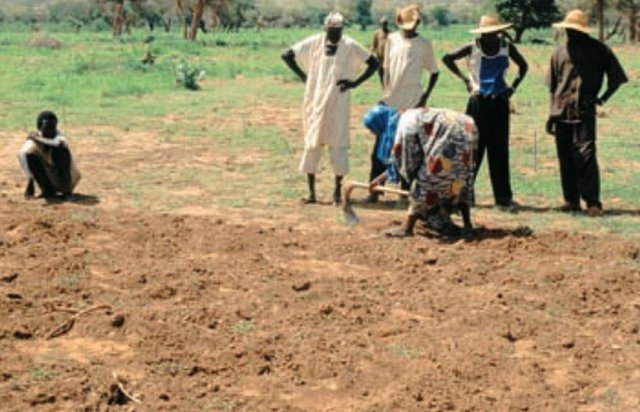
Approche participative de réhabilitation des terres individuelles et … [ប្រទេសនីហ្សេ]
Planification et gestion des terres individuelles et villageoises sur la base d’une participation des usagers ; promotion simultanée des activités des femmes.
- អ្នកចងក្រង៖ Eric Tielkes
2. ការពណ៌នាពីបច្ចេកទេស SLM
2.1 ការពណ៌នាដោយសង្ខេបពីបច្ចេកទេស
និយមន័យបច្ចេកទេស:
A combination of three measures to stabilise dunes: area closure, the use of palisades, and vegetative fixation through natural regeneration as
well as planting.
2.2 ការពណ៌នាលម្អិតពីបច្ចេកទេស
ការពណ៌នា:
In the Sahelian zone of Niger, sand dune encroachment can lead to loss of agricultural and pastoral land, and threatens villages. These dunes may form as a result of an increase in wind erosion, but more frequently originate from formerly stabilised dunes that have become mobile again following the disappearance of vegetation. Vegetation loss may occur through a combination of unfavourable climatic conditions and overexploitation by grazing and fuelwood gathering.
Purpose of the Technology: Sustainable dune fixation requires the regeneration of vegetation on the mobile parts of the dunes. For plants to establish, the dunes need to be protected by mechanical measures while being defended against any kind of use. Hence, the technique of dune stabilisation consists of a combination of three measures. These are as follows: (1) Area closure by wire fencing and guarding to prevent exploitation of the area during the rehabilitation phase until vegetation is sufficiently established (2-3 years). (2) Construction of millet stalk palisades arranged ideally in ‘checker-board’ squares, which act as windbreaks. These physical structures are a barrier to sand transport by wind, and thus are a prerequisite for revegetation. After two years the palisades fall apart and decompose - and the vegetation takes over the dune fixation function. Small erosion gullies can be controlled by check dams made from stone or millet stalks. (3) Natural regeneration, planting and seeding of annual and perennial plants (including Acacia spp. and Prosopis spp.) for soil stabilisation.
Establishment / maintenance activities and inputs: As soon as vegetation cover is established on the denuded surfaces the dunes can be used for grazing or for harvesting of herbs and fuelwood. Period and frequency of use should be determined in common agreement with all actors involved. In addition the pasture on the dune can be used as a ’reserve’ for late dry-season grazing, depending on vegetation development and herd size. Between 1991 and 1995, just over 250 ha of sand dunes were stabilised in the case study area. Incentives were provided by the ‘Projet de Développement Rural de Tahoua’ (PDRT, see also ‘Participatory land rehabilitation’ approach). After 1995 no further dunes were stabilised due to the high cost of the wire fencing, which local communities simply could not afford themselves. However, as the objective of the fence is to keep out humans and animals during critical periods (the rainy season), the same effect could be obtained at no financial cost through ‘social fencing’, that is agreement between stakeholders on where there should be no grazing. Furthermore the technology itself - which works well - could be relevant to situations where higher investment can be justified for specific reasons.
2.3 រូបភាពនៃបច្ចេកទេស
2.5 ប្រទេស/តំបន់/ទីតាំងកន្លែង ដែលបច្ចេកទេសត្រូវបានអនុវត្ត និងបានគ្រប់ដណ្តប់ដោយការវាយតម្លៃនេះ
ប្រទេស:
ប្រទេសនីហ្សេ
តំបន់/រដ្ឋ/ខេត្ត:
District of Tahoua
បញ្ជាក់ពីការសាយភាយនៃបច្ចេកទេស:
- ត្រូវបានផ្សព្វផ្សាយត្រឹមតំបន់មួយ
ប្រសិនបើបច្ចេកទេសត្រូវបានសាយភាយពាសពេញតំបន់ណាមួយ បញ្ជាក់ទំហំផ្ទៃដីអនុវត្តន៍ (គិតជា គ.ម2):
2,0
មតិយោបល់:
Total area covered by the SLM Technology is 2 km2.
Map
×2.7 ការណែនាំពីបច្ចេកទេស
សូមបញ្ជាក់តើបច្ចេកទេសត្រូវបានណែនាំឱ្យអនុវត្តដោយរបៀបណា:
- តាមរយៈគម្រោង / អន្តរាគមន៍ពីខាងក្រៅ
3. ចំណាត់ថ្នាក់នៃបច្ចេកទេស SLM
3.1 គោលបំណងចម្បង (១ ឬច្រើន) នៃបច្ចេកទេសនេះ
- កាត់បន្ថយ, បង្ការ, ស្តារឡើងវិញនូវការធ្លាក់ចុះគុណភាពដី
- reduce loss of land
3.2 ប្រភេទដីប្រើប្រាស់មួយប្រភេទ (ច្រើនប្រភេទ) ដែលបានអនុវត្តបច្ចេកទេស

ដីសម្រាប់ចិញ្ចឹមសត្វ
វាលស្មៅធំៗ:
- ពាក់កណ្តាលពនេចរ
- បែងចែកវាលស្មៅជាប្លុក
មតិយោបល់:
Major land use problems (compiler’s opinion): The area suffers from an imbalance between availability of natural resources (constrained by soil fertility and rainfall) and the rapid growth of the human and livestock populations. As a result, there is chronic food insufficiency and an associated overexploitation of the natural resource base. Accelerated wind and water erosion further enhance the degradation of the soil resources. From the farmers’ perspective, the main problems are lack of grazing land, wood and drinking water (due to sinking water tables), insufficient and unevenly distributed rainfall. Sand dunes are fragile: when overexploited, they soon remain with only unpalatable plant species, eg Panicum turgidum. When the vegetation cover on dunes decreases even further, dunes start moving again, threatening fields, villages or depressions used for fruit and vegetable cropping.
Longest growing period in days: 90; Longest growing period from month to month: Jul - Sep
3.4 ការផ្គត់ផ្គង់ទឹក
ការផ្គត់ផ្គង់ទឹកនៅកន្លែងអនុវត្តបច្ចេកទេស:
- ទឹកភ្លៀង
3.5 ក្រុម SLM ដែលបច្ចេកទេសស្ថិតនៅក្នុង
- តំបន់ទ្រនាប់ (បិទការប្រើប្រាស់ គាំទ្រដល់ការស្តារឡើងវិញ)
- ធ្វើឱ្យប្រសើរឡើងគម្របដី/ ដំណាំគម្របដី
3.6 វិធានការ SLM ដែលបញ្ចូលនូវបច្ចេកទេស

វិធានការរុក្ខជាតិ
- V1: ឈើធំៗ និងដើមឈើតូចៗ

វិធានការរចនាស័ម្ពន្ធ
- S6: ជញ្ជាំង, របាំង, របងឈើខ្ពស់ៗ

វិធានការគ្រប់គ្រង
- M1: ការផ្លាស់ប្តូរប្រភេទដីប្រើប្រាស់
3.7 កំណត់ប្រភេទនៃការធ្លាក់ចុះគុណភាពដីសំខាន់ៗដែលបច្ចេកទេសនេះបានដោះស្រាយ

ការបាត់ដីដោយសារខ្យល់
- Et: ការបាត់បង់ដីស្រទាប់លើ
- Eo: ផលប៉ះពាល់នៃការធ្លាក់ចុះគុណភាព

ការធ្លាក់ចុះសារធាតុគីមីក្នុងដី
- Cn: ការថយចុះជីជាតិ និងកាត់បន្ថយបរិមាណសារធាតុសរីរាង្គ (មិនកើតឡើងដោយការហូរច្រោះទេ)

ការធ្លាក់ចុះជីវសាស្ត្រនៃដី
- Bs: សមាសភាពដែលមានគុណភាពនិងប្រភេទសត្វ/ការថយចុះនូវជីវចម្រុះ
មតិយោបល់:
Main causes of degradation: droughts (manque de pluie; pluie mal répartie), land tenure, faim
Secondary causes of degradation: soil management (pas de jachère; pas suffisamment d'intrants. Mulching, engrais, mat. organique), deforestation / removal of natural vegetation (incl. forest fires) (combustibles), over-exploitation of vegetation for domestic use, overgrazing, population pressure (croissance de la population), poverty / wealth (Manque de moyens financiers), labour availability, education, access to knowledge and support services
3.8 ការពារ កាត់បន្ថយ ឬស្តារឡើងវិញនៃការធ្លាក់ចុះគុណភាពដី
បញ្ជាក់ពីគោលដៅរបស់បច្ចេកទេស ដែលផ្តោតទៅការធ្លាក់ចុះគុណភាពដី:
- ការការពារការធ្លាក់ចុះគុណភាពដី
- ការជួសជុល/ ស្តារឡើងវិញនៃឱនភាពដីធ្ងន់ធ្ងរ
4. បច្ចេកទេសជាក់លាក់ សកម្មភាពអនុវត្ត ធាតុចូល និងថ្លៃដើម
4.1 គំនូសបច្ចេកទេសនៃបច្ចេកទេសនេះ
លក្ខណៈពិសេសនៃបច្ចេកទេស (ទាក់ទងនឺងគំនូរបច្ចេកទេស):
Sand dunes in the process of stabilisation: millet stalk palisades hinder detachment and displacement of sand particles through wind, and help vegetative cover to re-establish. Fences exclude animals during the restoration process.
Technical knowledge required for field staff / advisors: moderate
Technical knowledge required for land users: low
Main technical functions: improvement of ground cover, sediment retention / trapping, sediment harvesting, reduction in wind speed, stabilise sand dune surface, control detachment of particles by wind
Secondary technical functions: increase in organic matter
Agronomic measure: regenerated and seeded vegetation cover
Structural measure: millet stalk palisades
Structural measure: check dams (optional)
Change of land use practices / intensity level: area closure, controlled grazing
ឈ្មោះអ្នកនិពន្ធ:
Mats Gurtner
4.2 ព័ត៌មានទូទៅដែលពាក់ព័ន្ធនឹងការគណនាធាតុចូល និងថ្លៃដើម
កំណត់រូបិយប័ណ្ណសម្រាប់ថ្លៃដើម:
- ដុល្លារ
4.3 សកម្មភាពបង្កើត
| សកម្មភាព | រយៈពេល (រដូវកាល) | |
|---|---|---|
| 1. | Construction of wire fence around the dune | December to June |
| 2. | Palisade construction, 2000 m/ha. | December to June |
| 3. | Guarding the fenced area | all year round |
4.4 ថ្លៃដើម និងធាតុចូលដែលត្រូវការសម្រាប់ការបង្កើតបច្ចេកទេស
| បញ្ជាក់ពីធាតុចូល | ឯកតា | បរិមាណ | ថ្លៃដើមក្នុងមួយឯកតា | ថ្លៃធាតុចូលសរុប | % នៃថ្លៃដើមដែលចំណាយដោយអ្នកប្រើប្រាស់ដី | |
|---|---|---|---|---|---|---|
| កម្លាំងពលកម្ម | Enclose area and protect | ha | 1,0 | 300,0 | 300,0 | 100,0 |
| សម្ភារៈ | Tools | ha | 1,0 | 10,0 | 10,0 | |
| សម្ភារៈដាំដុះ | Tree seedlings | ha | 1,0 | 20,0 | 20,0 | |
| សម្ភារៈសាងសង់ | Wire fence | ha | 1,0 | 1120,0 | 1120,0 | |
| ថ្លៃដើមសរុបក្នុងការបង្កើតបច្ចេកទេស | 1450,0 | |||||
| ថ្លៃដើមសរុបក្នុងការបង្កើតបច្ចេកទេសគិតជាដុល្លារ | 1450,0 | |||||
មតិយោបល់:
Duration of establishment phase: 36 month(s)
In the Sahelian zone of Niger, wind erosion constitutes one of the major causes of land degradation. Measures to combat wind erosion and sand encroachment were developed through a rural development project. However in this case the cost was too high to justify continuation: nevertheless the technology itself may be applicable in other situations
4.5 សកម្មភាពថែទាំ
| សកម្មភាព | ពេលវេលា/ ភាពញឹកញាប់ | |
|---|---|---|
| 1. | Harvesting of millet stalks , 2,000 bundles/ha (1 bundle = 6-10 kg). | October to February / initial establishment |
| 2. | Seeding of herbaceous plants | May, just before rainy season / initial establishment |
| 3. | Transplanting of locally available trees reared in a tree nursery | June to July, early rainy season / initial establishment |
| 4. | Replanting of dead tree/shrub seedlings (20% replanting). | June to July / |
| 5. | Guarding the area closure | all year round / |
| 6. | Controlled grazing once the dune has been stabilised: for periods of between 1 day and a week every 2 to 3 weeks – as determined | / between 1 day and a week every 2 to 3 weeks |
4.6 កំណត់ថ្លៃដើមសម្រាប់ការថែទាំ/ សកម្មភាពរបស់បច្ចេកទេស (ក្នុងរយៈពេលមួយឆ្នាំ)
| បញ្ជាក់ពីធាតុចូល | ឯកតា | បរិមាណ | ថ្លៃដើមក្នុងមួយឯកតា | ថ្លៃធាតុចូលសរុប | % នៃថ្លៃដើមដែលចំណាយដោយអ្នកប្រើប្រាស់ដី | |
|---|---|---|---|---|---|---|
| កម្លាំងពលកម្ម | Maintain area and guarding | ha | 1,0 | 45,0 | 45,0 | 100,0 |
| សម្ភារៈដាំដុះ | Tree seedlings | ha | 1,0 | 5,0 | 5,0 | |
| ថ្លៃដើមសរុបសម្រាប់ការថែទាំដំណាំតាមបច្ចេកទេស | 50,0 | |||||
| ថ្លៃដើមសរុបសម្រាប់ការថែទាំដំណាំតាមបច្ចេកទេសគិតជាដុល្លារ | 50,0 | |||||
មតិយោបល់:
Labour (per ha, for establishment) includes installing wire fence (16 person days), collecting and transporting millet stalks and installing palisades (175 person days), sowing of herbaceous plants (2 person days), planting tree/shrub species (6 person days). Seedlings: under PDRT the tree nursery was financed by the project and the plants delivered to the ‘village’ - planting was done by the local population.
5. លក្ខណៈបរិស្ថានធម្មជាតិ និងមនុស្ស
5.1 អាកាសធាតុ
បរិមាណទឹកភ្លៀងប្រចាំឆ្នាំ
- < 250 មម
- 251-500 មម
- 501-750 មម
- 751-1,000 មម
- 1,001-1,500 មម
- 1,501-2,000 មម
- 2,001-3,000 មម
- 3,001-4,000 មម
- > 4,000 មម
កំណត់បរិមាណទឹកភ្លៀង (បើដឹង) ជា មីលីម៉ែត្រ:
300,00
តំបន់កសិអាកាសធាតុ
- មានភ្លៀងតិចតួច
5.2 សណ្ឋានដី
ជម្រាលជាមធ្យម:
- រាបស្មើ (0-2%)
- ជម្រាលតិចតួច (3-5%)
- មធ្យម (6-10%)
- ជម្រាលខ្ពស់បន្តិច (11-15%)
- ទីទួល (16-30%)
- ទីទួលចោត (31-60%)
- ទីទួលចោតខ្លាំង (>60%)
ទម្រង់ដី:
- ខ្ពង់រាប
- កំពូលភ្នំ
- ជម្រាលភ្នំ
- ជម្រាលទួល
- ជម្រាលជើងភ្នំ
- បាតជ្រលងភ្នំ
តំបន់តាមរយៈកម្ពស់ :
- 0-100 ម
- 101-500 ម
- 501-1,000 ម
- 1,001-1,500 ម
- 1,501-2,000 ម
- 2,001-2,500 ម
- 2,501-3,000 ម
- 3,001-4,000 ម
- > 4,000 ម
5.3 ដី
ជម្រៅដីជាមធ្យម:
- រាក់ខ្លាំង (0-20 សម)
- រាក់ (21-50 សម)
- មធ្យម (51-80 សម)
- ជ្រៅ (81-120 សម)
- ជ្រៅខ្លាំង (> 120 សម)
វាយនភាពដី (ស្រទាប់លើ):
- គ្រើម/ មានពន្លឺ (ខ្សាច់)
សារធាតុសរីរាង្គនៅស្រទាប់ដីខាងលើ:
- ទាប (<1%)
បើអាចសូមភ្ជាប់ការពណ៌នាពីដីឱ្យបានច្បាស់ ឬព័ត៌មានដែលអាចទទួលបាន ឧ. ប្រភេទដី, pH ដី/ ជាតិអាស៊ីត, សមត្ថភាពផ្លាស់ប្តូរកាចុង, វត្តមាននីត្រូសែន, ភាពប្រៃ ។ល។:
Soil fertility is low
Soil drainage / infiltration is good
5.6 លក្ខណៈនៃអ្នកប្រើប្រាស់ដីដែលអនុវត្តបច្ចេកទេស
ទីផ្សារនៃប្រព័ន្ធផលិតកម្ម:
- ពាក់កណ្តាលពាណិជ្ជកម្ម (ផ្គត់ផ្គង់ខ្លួនឯង/ ពាណិជ្ជកម្ម)
ចំណូលក្រៅកសិកម្ម:
- ច្រើនជាង 50% នៃចំណូល
សូមបញ្ជាក់ពីលក្ខណៈពាក់ព័ន្ធផ្សេងទៀតអំពីអ្នកប្រើប្រាស់ដី:
Off-farm income specification: due to out-migration of labour, commerce and also arts and crafts
5.7 ទំហំផ្ទៃដីជាមធ្យមនៃដីប្រើប្រាស់ដោយអ្នកប្រើប្រាស់ដី ក្នុងការអនុវត្តបច្ចេកទេស
- < 0.5 ហិកតា
- 0.5-1 ហិកតា
- 1-2 ហិកតា
- 2-5 ហិកតា
- 5-15 ហិកតា
- 15-50 ហិកតា
- 50-100 ហិកតា
- 100-500 ហិកតា
- 500-1,000 ហិកតា
- 1,000-10,000 ហិកតា
- > 10,000 ហិកតា
មតិយោបល់:
Average area of land owned or leased by land users applying the Technology: Also 15-50 ha
5.8 ភាពជាម្ចាស់ដី កម្មសិទ្ធប្រើប្រាស់ដី និងកម្មសិទ្ធប្រើប្រាស់ទឹក
ភាពជាម្ចាស់ដី:
- ភូមិ
កម្មសិទ្ធិប្រើប្រាស់ដី:
- អាស្រ័យផលសេរី (មិនមានការកំណត់)
6. ផលប៉ះពាល់ និងការសន្និដ្ឋាន
6.1 ផលប៉ះពាល់ក្នុងបរិវេណអនុវត្តបច្ចេកទេសដែលកើតមាន
ផលប៉ះពាល់លើសេដ្ឋកិច្ចសង្គម
ផលិតផល
ផលិតកម្មឈើ
ផ្ទៃដីផលិតកម្ម
មតិយោបល់/ ការបញ្ជាក់:
temporary loss of land, reduced access to pastures
ការគ្រប់គ្រងដី
ចំណូល និងថ្លៃដើម
ការចំណាយលើធាតុចូលកសិកម្ម
មតិយោបល់/ ការបញ្ជាក់:
Millet stalks are taken from the fields where they have a function as mulch and fodder
បន្ទុកការងារ
ផលប៉ះពាល់ទៅលើសេដ្ឋកិច្ចសង្គមផ្សេងៗ
initial costs
ផលប៉ះពាល់ទៅលើវប្បធម៌សង្គម
ស្ថាប័នសហគមន៍
ចំណេះដឹង SLM / ការធ្លាក់ចុះគុណភាពដី
ការកាត់បន្ថយជម្លោះ
មតិយោបល់/ ការបញ្ជាក់:
Socio-cultural conflicts between agriculturalists and pastoralists
requires concerted action
មតិយោបល់/ ការបញ្ជាក់:
Requires concerted action from all land users during, but even more after, rehabilitation
ផលប៉ះពាល់ទៅលើអេកូឡូស៊ី
ដី
សំណើមដី
គម្របដី
ការបាត់បង់ដី
ការកាត់បន្ថយហានិភ័យនៃគ្រោះមហន្តរាយ និងគ្រោះអាកាសធាតុ
ល្បឿនខ្យល់
ផលប៉ះពាល់ទៅលើអេកូឡូស៊ីផ្សេងៗ
soil fertility
biodiversity
soil erosion locally
6.2 ផលប៉ះពាល់ក្រៅបរិវេណអនុវត្តបច្ចេកទេសដែលកើតមាន
ខ្យល់នាំយកនូវធូរលី
land or village protected from sand encroachment
វាយតម្លៃផលប៉ះពាល់ក្រៅបរិវេណអនុវត្តបច្ចេកទេស (វាស់វែង):
Off-site benefits are difficult to assess and do not necessarily accrue to the local land users
6.4 ការវិភាគថ្លៃដើម និងអត្ថប្រយោជន៍
តើផលចំណេញ និងថ្លៃដើមត្រូវបានប្រៀបធៀបគ្នាយ៉ាងដូចម្តេច (ទស្សនៈរបស់អ្នកប្រើប្រាស់ដី)?
រយៈពេលខ្លី:
អវិជ្ជមានខ្លាំង
រយៈពេលវែង:
អវិជ្ជមាន
តើផលចំណេញ និងការថែទាំ/ ជួសជុលត្រូវបានប្រៀបធៀបគ្នាយ៉ាងដូចម្តេច (ទស្សនៈរបស់អ្នកប្រើប្រាស់ដី)?
រយៈពេលខ្លី:
អវិជ្ជមាន
រយៈពេលវែង:
អវិជ្ជមាន
6.5 ការទទួលយកបច្ចេកទេស
ក្នុងចំណោមគ្រួសារទាំងអស់ដែលបានអនុវត្តបច្ចេកទេស តើមានប៉ុន្មានគ្រួសារដែលចង់ធ្វើដោយខ្លួនឯង ដោយមិនទទួលបានសម្ភារៈលើកទឹកចិត្ត/ប្រាក់ឧបត្ថម្ភ?:
- 0-10%
មតិយោបល់:
There is no trend towards spontaneous adoption of the Technology
Comments on adoption trend: There is no spontaneous adoption as the technology is too expensive, labour intensive, and implemented on communal land.
6.7 ភាពខ្លាំង/ គុណសម្បត្តិ/ ឱកាសនៃបច្ចេកទេស
| ភាពខ្លាំង/ គុណសម្បត្តិ/ ឱកាស ទស្សនៈរបស់បុគ្គលសំខាន់ៗ |
|---|
|
Technically it is feasible to prevent dune encroachment and hence reduce the danger it exerts on arable/pastoral land and villages How can they be sustained / enhanced? Prevent overexploitation, apply SWC measures that are technically and financially feasible (eg use cheaper fencing material or ‘social fencing’). |
|
Decrease loss of arable/pastoral land How can they be sustained / enhanced? Prevent overexploitation. |
|
Additional income to the land user How can they be sustained / enhanced? Planting multipurpose tree/shrub species on the protected dunes, encourage pasture management systems eg rotational grazing. |
6.8 ភាពខ្សោយ/ គុណវិបត្តិ/ ហានិភ័យនៃបច្ចេកទេស និងវិធីសាស្ត្រដោះស្រាយ
| ភាពខ្សោយ/ គុណវិបត្តិ/ ហានិភ័យ ទស្សនៈរបស់អ្នកចងក្រងឬបុគ្គលសំខាន់ៗ | តើបច្ចេកទេសទាំងនោះបានដោះស្រាយបញ្ហាដូចម្តេច? |
|---|---|
| Soil cover is very sensitive to overexploitation |
In order to increase acceptance, involve the whole community in the planning and management processes of the stabilised dune. |
| Social conflicts between farmers and herders due to area closure | In order to increase acceptance, involve all actors, including pastoralists or their representatives, in the planning and management process of the stabilised dune. |
|
Use materials for the palisades that do not have an alternative use as fodder (as millet stalks do) for example twigs of Leptadenia pyrotechnica). Plastic nets exist for making palisades, but these are very expensive. Labour requirements difficult to circumvent. |
Initiate the establishment of sustainable management systems eg communally managed rotational grazing systems. |
|
Area closure to prevent exploitation of stabilised dunes means restricted access to potential grazing areas |
Involved actors can agree upon a local convention that prohibits access during rehabilitation – ‘social fencing’ – and restricted exploitation after this phase. PDRT started to plant Euphorbia balsamifera within the fence with the idea of eventually removing and using it on another site. |
| High costs for fencing |
7. ឯកសារយោង និងវេបសាយ
7.1 វិធីសាស្ត្រ/ ប្រភពនៃព័ត៌មាន
ការតភ្ជាប់ និងម៉ូឌុល
ពង្រីកមើលទាំងអស់ បង្រួមទាំងអស់ការតភ្ជាប់

Approche participative de réhabilitation des terres individuelles et … [ប្រទេសនីហ្សេ]
Planification et gestion des terres individuelles et villageoises sur la base d’une participation des usagers ; promotion simultanée des activités des femmes.
- អ្នកចងក្រង៖ Eric Tielkes
ម៉ូឌុល
គ្មានម៉ូឌុល


